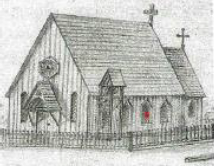History
The story of the preservation of St. Mark'sSt. Mark’s: An architectural treasure
St. Mark’s Episcopal Church in Palatka is an architectural treasure. The charming white Carpenter Gothic church with bright red front doors is an example of community art in Palatka. For 169 years, people have admired its splendid architecture as they travel down the original brick streets of the town – walking, biking, riding in horse-drawn carriages, in gasoline-powered Model Ts and now electric vehicles. The beautiful little church has been a constant in the memories of Palatka to passersby, visitors, neighbors and focused observers. The stories of pioneer Florida and the people who were stewards of the church are a legacy seen in their visions of what the city and even the new state of Florida could be. St. Mark’s Episcopal Church in Palatka, recognized by the National Trust for Historic Preservation, clearly defines the place of the nationally-acknowledged Carpenter Gothic architectural style.
St. Mark’s may be considered the forerunner for Upjohn’s Carpenter Gothic style in Florida, where as many as 60 white wooden Gothic churches with red front doors were built in the state following the Civil War. Area examples of his Carpenter Gothic style can be seen in Federal Point, Welaka, Crescent City, Green Cove Springs, Fleming Island, St. Mark’s in Starke and Church of Our Saviour in Mandarin.
Church tours are available with our Docent and the St. Mark’s library and archives are available by appointment. Contact us at office@stmarkspalatka.org to schedule.




St. Mark’s Church Palatka. Photo by Mathew Benjamin Brady, c.1870. Photo courtesy Canadian Centre for Architecture, Montreal, Quebec.

Sketch by the granddaughter of the artist, a Union assistant surgeon stationed on a gunboat at Palatka. c. Jan. 2, 1868


The organizers of St. Mark’s in 1853 were legacy leaders in Florida and several of those St. Mark’s Parish organizers met in St. Augustine as the original members of the Florida Historical Society:
- Gov. William D. Moseley, first elected governor of the state and Elizabeth Moseley Haughton, daughter of Governor Moseley, who proposed the organizing of an Episcopal church in Palatka.
- Her husband, Judge T.S. Haughton, was a direct descendant of two Florida pioneers: Francis Philip Fatio, one of only two land grant holders in continued residence in North Florida with a 10,000-acre land grant from the British occupation, the Second Spanish Period, and the Florida territorial transition; and Fatio’s grandson, Francis P. Fleming, who served as governor of Florida from 1889-1893.
- Judge Isaac Bronson, at attorney in Watertown, NY, was appointed to the U.S. Congress in 1837 and introduced the act by which Florida became a state in 1845. President James K. Polk appointed Bronson to the Southern District superior federal court and Bronson made his headquarters in St. Augustine. In 1854, Bronson built his palatial home in Palatka, Sunny Point, now known as the Bronson-Mulholland House.
- Judge Bronson and Bishop Benjamin Whipple were instrumental in persuading New York architect Richard Upjohn to design St. Mark’s for a fee within the building committee’s budget.
- Benjamin Putnam for whom Putnam County was named. Putnam was speaker of the state House of Representatives, major in the Seminole War, surveyor general of Florida, and circuit judge in Palatka. His only child Kate was the daughter-in-law of U.S. Secretary of War, John C. Calhoun. His widow, Helen Kirby Putnam, donated the land on which the St. Mark’s rectory is located.
- James Burt was the driving force in the development of Palatka and the construction of the Upjohn-designed church and rectory at St. Mark’s. He was a banker, successful mercantile businessman with his brother George Burt in St. Augustine, Palatka Tract trustee and for 40 years he served St. Mark’s as its treasurer, vestryman and junior warden.
- George R. Fairbanks moved as a law clerk with Judge Bronson from Watertown, NY. In 1855, Fairbanks delivered the application of St. Mark’s to the Diocese Convention in Tallahassee, which was unanimously approved. He became the Clerk of the Circuit Court, Florida State Senator, president of Florida Fruit Growers Association, the author of books on Florida history; and was a founder of the University of the South in Sewanee, Tenn.
- Robert Boyd, one of the first settlers in Palatka, built a house that was one of the first three in town with glass windows. He served as sheriff, tax assessor, and tax collector of Putnam County, all at one time.
- Dr. George Hawes opened his medical practice in Palatka in 1852, served in the Florida Senate from 1848-1861 and served St. Mark’s as Senior Warden for 42 years.
- Hubbard Hart, was an entrepreneur and owner of the Hart Line steamboat empire and hotel venue which became the catalyst for Florida’s nascent tourist industry on the St. Johns and Ocklawaha rivers.
- Marcellus A. Williams was one of the most important U.S. Government surveyors in Florida history. He studied surveying with George Washington’s nephew Lawrence Washington. In 1870, Williams surveyed all of the real property at the southern tip of the state between the Everglades and the Atlantic Ocean, the Intracoastal Waterway between Lake Worth to Fort Myers, and from Amelia Island to Cedar Key.
- Judge Isaac Bronson and his wife, Sophronia, donated the land upon which the St. Mark’s sanctuary was constructed in 1855 under the supervision of church secretary, James Burt. Bronson as a U.S. congressman sponsored the bill that included Florida as a state and Palatka as an incorporated city.
For more information on the history of St. Mark’s, the following resources are available (blue links are PDF files):
- Antebellum History of St. Mark’s
- St. Mark’s Episcopal Church and its Significant Contribution to the Occupation of Palatka 1864
- 169th Birthday of St. Mark’s (from to The Palatka Daily News)
- St. Mark’s Parish Register 1853-1887
- In Rememberance of Me: St. Mark’s Episcopal Church Palatka: 1853-2003 by Nancy Ayers (available for purchase)
- Tour of St. Mark’s stained glass
